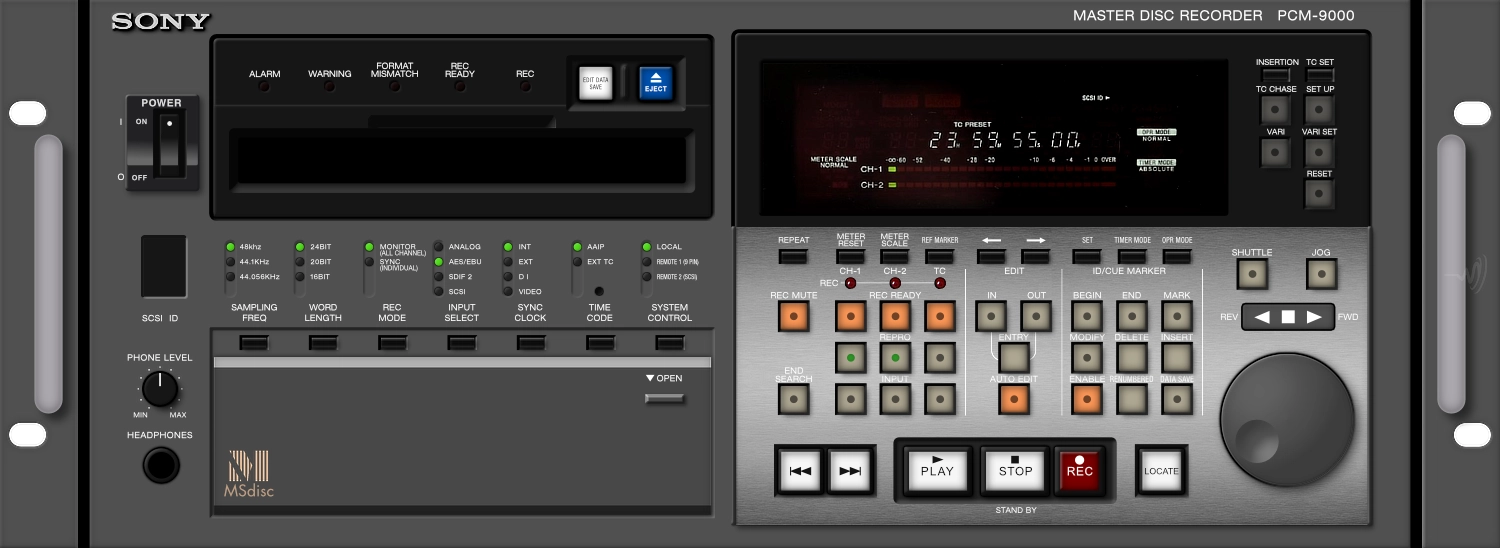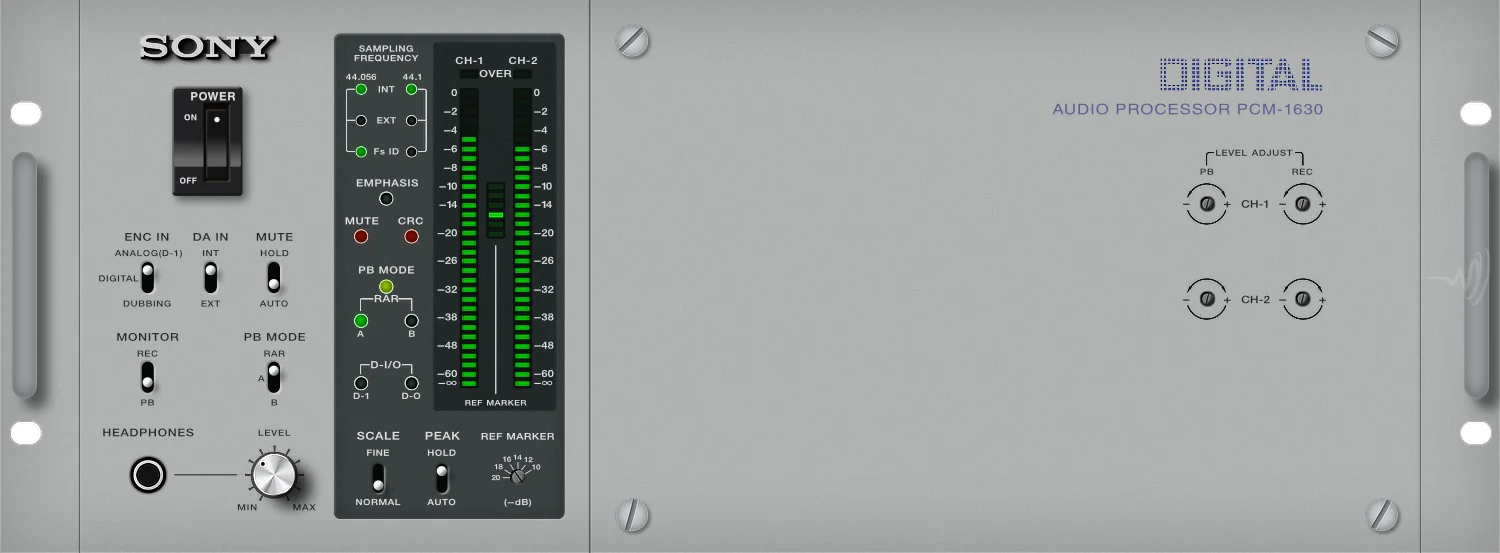The Sony PCM-9000 represented a significant breakthrough in audio recording technology, as it allows up to 80 minutes of two-channel audio to be stored in 20-bit linear mode using an overwritable MO disc. This medium not only offers excellent sound quality to the Digital Master Disc Recorder, but also provides operational benefits such as rapid access and non-linear editing. Additionally, the recording medium can be removed for storage or swapped with other machines.
This innovative recorder is well-suited for a wide range of applications, including making master recordings for CD/MD production, broadcast operations, and post-production. Its introduction marked a significant milestone in the history of audio recording technology, as it demonstrated the possibilities and potential of utilising high-resolution digital recording equipment for professional audio applications.
The Sony PCM-9000 utilises the MSD-1200 digital audio master disc, which is a single-sided magneto-optical (MO) disc that measures 133 mm (5.25 inches) in diameter and is housed in a protective cartridge that measures 143.7 x 160.5 x 10.9 mm. Despite its small size, the use of Constant Linear Velocity (CLV) recording technology enables each MO disc to hold approximately 1.3GB of data. This allows for the recording of two channels of digital audio for 80 minutes in 20-bit linear recording mode, 65 minutes in 24-bit, and 100 minutes in 16-bit.
The MO disc is divided into two data areas: the MAIN data area, where audio data is recorded, and the AUX data area, where cue and non-destructive editing data are stored. The MO disc allows for repeated recording and playback, and the lack of contact between the disc and the recorder during operation ensures excellent durability for both components.
During manufacturing, the MSD-1200 digital audio master disc is pre-grooved across its entire recording area, with the pre-groove containing absolute address information (AAIP). This eliminates the need for disc formatting when using a new disc. The Sony PCM-9000 converts this AAIP into SMPTE/EBU time code for the timer display, with an offset that can be easily added using the numeric keys or the jog dial of the optional remote controller. Moreover, a PCM-9000 fitted with an optional DABK-9003 remote TC interface board can output this SMPTE/EBU time code. This feature set makes the Sony PCM-9000 a cutting-edge tool for professional digital audio processing.
The Sony RM-D9000 remote controller offers four distinct operational modes for the PCM-9000: Normal, Disc, File, and Copy. In the Normal mode, the device can record and playback two channels of digital audio using the MAIN data area of the MO disc. The two channels can be recorded together or separately, with the option to use Sync-Rec and Monitor-Rec operations for precise recording.
The Normal mode also includes an auto punch in/out function and the ability to memorise the addresses of the IN and OUT points automatically. BEGIN and END points can be set at any location along the recorded track, and up to 999 pairs of points can be stored in the AUX data area of the disc. Track numbers are set automatically, and the Normal mode includes a straightforward push button track renumber function.
The Sony PCM-9000 from Sony offers four different operational modes through the use of the RM-D9000 remote controller. The first mode, called disc mode, enables quick track selection and renumbering, allowing the user to play back a single track selected in normal mode. The second mode, file mode, provides non-linear operation and the ability to rearrange track order without altering the digital audio signal in the MAIN data area. Up to nine program play files can be saved to the AUX data area of the disc. In this mode, the pause time between tracks can be set to either 0 or 2 seconds.
The third mode, copy mode, allows for the transfer of both MAIN data and AUX data to a second Sony PCM-9000, with the transfer speed being twice as fast when using the optional DABK-9005 SCSI interface board. The order of transfer is determined in the file mode.
The normal mode provides the ability to record and play back two channels of digital audio using the MAIN data area of the MO disc, with the option to record the channels together or separately. The mode includes Sync-Rec and Monitor-Rec operations, auto punch in/out function, and the ability to set up to 999 pairs of IN and OUT points, with track numbers being set automatically. The mode also includes a track renumber function.
When the Sony PCM-9000 is equipped with the RM-D9000 remote controller, it offers jog and shuttle functions. The shuttle mode allows for monitoring of track jump sound, while the jog mode requires the optional DABK-9007 memory board to provide digital jog sound for precise searching. Recording and reproduction speeds can be adjusted by ±12.5% in 0.1% increments using the numeric keys or jog dial on the RM-D9000.
With editing accuracy of one block and the DABK-9007 memory board, the Sony PCM-9000 allows for editing to a precision of one sample and provides crossfades at each edit point. Sampling frequency options include 48kHz, 44.1 kHz, and 44.056 kHz. The device is well-suited for digital audio two-channel recording/playback applications such as CD mastering, laser disc production, and digital video production.
The optimise mode erases unnecessary data and re-records the remaining data back onto the disc when the MAIN data area is fully occupied, maximising the disc’s storage capacity. The Sony RM-D9000 remote controller offers two timer display modes: normal and disc. The normal mode offers selectable timer modes such as ABSOLUTE, RELATIVE, or REMAIN, displaying either the absolute time converted from AAIP, time elapsed since the counter reset, or remaining time of the disc. In the disc mode, users can choose between ACTUAL or REMAIN, showing track number and time within the track. The ACTUAL mode displays actual playing time while the REMAIN mode shows the remaining time.
Apart from the normal record function, the Sony PCM-9000 features two erase modes, namely instant erase and disc erase modes. The instant erase mode erases only the AUX data within a few seconds, allowing for overwriting with new audio data. However, after this erasure, the MAIN audio data cannot be played back. On the other hand, the disc erase mode erases all the data on both the AUX and MAIN areas, and this process takes approximately 20 minutes.
The MSD-1200 cartridge has two record protection levels to prevent accidental operation. One protects only the MAIN data area, while the other protects both the MAIN and AUX data areas. The Sony PCM-9000 is also equipped with a disc condition check function that warns the user to clean the disc if the surface exceeds a certain level of contamination.
The extensive use of LSIs developed for the Sony PCM-9000 has allowed a significant reduction in the number of signal processing boards. This has resulted in the PCM-9000 being very compact and with the low consumption of 130W. The PCM-9000 can be mounted in a 19-inch standard rack, taking only 4 units of height.
The Sony PCM-9000 operates using a proprietary recording format, which functions as follows:
When magnetic material is heated beyond a critical temperature known as the Curie Point (named after Pierre Curie), its magnetisation disappears. As the material cools, it adopts the magnetic polarity of any applied magnetic field. This magnetic field aligns the disc’s spots to a north or south polarity, corresponding to the digital bitstream’s ones or zeros. Once the temperature drops below the Curie Point, the magnetic polarity remains fixed until reheated. The disc’s polarity is then read by a laser using the Kerr principle, which involves a slight rotation of the light’s polarisation plane by a magnetic field. The professional version of this system utilises a 133-millimeter single-sided disc capable of storing over 100 minutes of recorded data. Once remagnetised, the discs are sealed to prevent air from corroding the magnetic material. This system supports up to 24-bit quantisation levels and sampling rates of 48kHz, 44.1kHz, and 44.056kHz.
The Sony PCM-9000 is regarded as the logical successor to the PCM-1630 CD mastering system, (while the MiniDisc is intended to replace the compact cassette for portable use).



